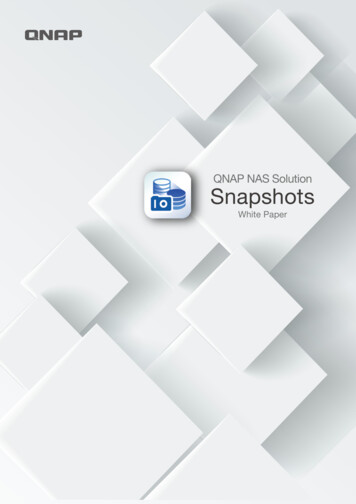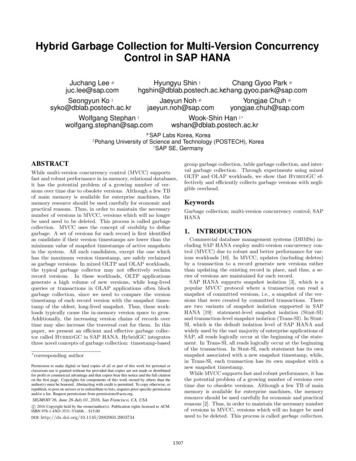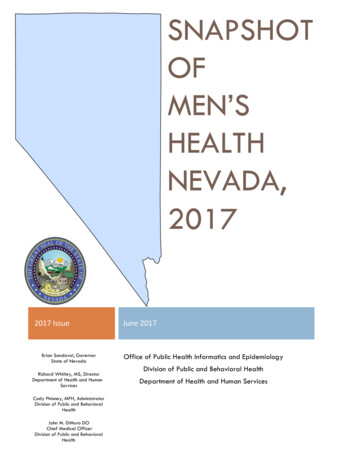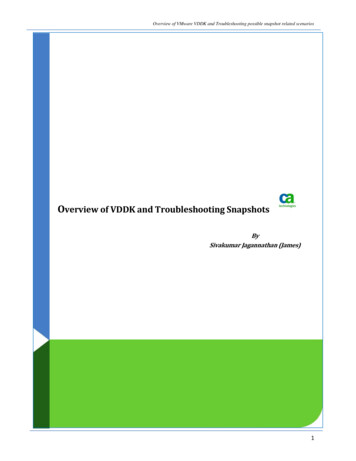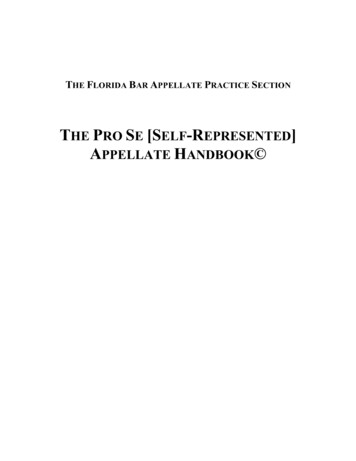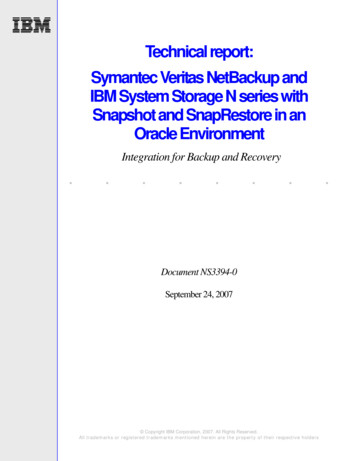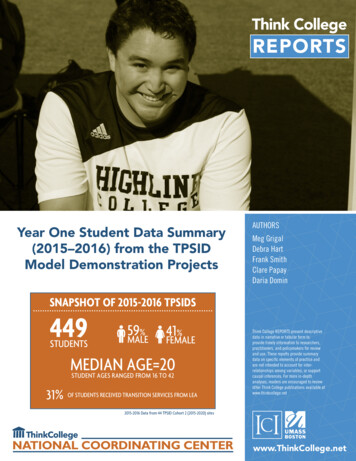
Transcription
Think CollegeREPORTSYear One Student Data Summary(2015–2016) from the TPSIDModel Demonstration ProjectsAUTHORSMeg GrigalDebra HartFrank SmithClare PapayDaria DominSNAPSHOT OF 2015-2016 TPSIDS449STUDENTS59%MALE41%FEMALEMEDIAN AGE 20STUDENT AGES RANGED FROM 16 TO 4231% OF STUDENTS RECEIVED TRANSITION SERVICES FROM LEAThink College REPORTS present descriptivedata in narrative or tabular form toprovide timely information to researchers,practitioners, and policymakers for reviewand use. These reports provide summarydata on specific elements of practice andare not intended to account for interrelationships among variables, or supportcausal inferences. For more in-depthanalyses, readers are encouraged to reviewother Think College publications available atwww.thinkcollege.net2015-2016 Data from 44 TPSID Cohort 2 (2015-2020) sitesThinkCollegeNATIONAL COORDINATING CENTERwww.ThinkCollege.net
THINK COLLEGE REPORTSYear One Student Data Summary (2015–2016)from the TPSID Model Demonstration ProjectsThis summary report offers an overview of the descriptivedata on students with intellectual disability collected bythe Think College National Coordinating Center fromthe institutions of higher education implementing modeldemonstration projects under the Transition PostsecondaryPrograms for Students with Intellectual Disability (TPSID)program funded in 2015 by the Office of PostsecondaryEducation, US Department of Education.Students with Intellectual Disability, or TPSID, modeldemonstration program was first implemented by theOffice of Postsecondary Education (OPE) in 2010 throughfive-year grants awarded to 27 institutes of highereducation (IHEs). Grants were awarded again in 2015 to asecond cohort of 25 IHEs to implement TPSID programsbetween 2015 and 2020. These IHEs were tasked withcreating, expanding, or enhancing high-quality, inclusivehigher education experiences to support positive outcomesfor individuals with intellectual disability.The Higher Education Act as amended in the HigherEducation Opportunity Act 2008 (HEOA) containedseveral provisions aimed at increasing access to highereducation for youth and adults with intellectual disability.One outcome of these provisions was the appropriationof funds by Congress to create a model demonstrationprogram aimed at developing inclusive higher educationoptions for people with intellectual disability.The HEOA also authorized the establishment of aNational Coordinating Center for the TPSID programsto support coordination, training, and evaluation. ThisNational Coordinating Center (NCC) was awarded tothe Institute for Community Inclusion at the Universityof Massachusetts Boston. The mission of the NCCis to provide technical assistance to IHEs that offercomprehensive transition and postsecondary programsfor students with intellectual disability. The NCCalso evaluates the overall TPSID program, createsrecommended standards for programs, and builds a validknowledge base around program components.The Transition Postsecondary Education Program forThis report provides an overview of the descriptiveBACKGROUNDTPSID 2015-2020 GRANTEESVTMACT RI25 grantees19 satellite sites44 total sitesNational Coordinating CenterHIThinkCollegeNATIONAL COORDINATING CENTERwww.thinkcollege.net2 YEAR ONE STUDENT DATA SUMMARY
Type of IHEState Lead granteeALSites2-yearType of students served4-yearJacksonville State UniversityJacksonville State UniversityxUniversity of AlabamaUniversity of AlabamaxUniversity of South AlabamaUniversity of South AlabamaxDually enrolledAlready exitedhigh schoolBothApproved asa CTPNumber of studentsserved in 2015-160**x340**CACalifornia State University Fresno California State University Fresno*xxCOColorado State Universityxx10FLUniversity of Central FloridaColorado State University*Florida Consortium on Inclusive HigherEducation/UCFFlorida International University (Panther LIFE)xx10Florida International University (Panther PLUS)xFlorida State College at JacksonvillexUniversity of South Florida St. Petersburg*xGAHIGeorgia State UniversityAlbany Technical CollegeUniversity of Hawaii at Manoax193East Georgia State CollegexxUniversity of GeorgiaxxKapiolani Community CollegexLeeward Community College*x350**x10x1xUniversity of Missouri Kansas City UMKC Propel ProgramxNCAppalachian State UniversityAppalachian State University*xNDMinot State UniversityMinot State University*NJBergen Community CollegeBergen Community College*Ohio State UniversityxxxMOOH0**xUniversity of KansasUniversity of Rochester30Columbus State UniversityHonolulu Community College*300**University of KansasSyracuse UniversityxxKSNYx4xxxxx0**x22x4x5x29College of New Jersey*xxSyracuse UniversityCity University of New York — Borough ofManhattan Community CollegeCollege of Staten IslandxxxHostos Community CollegexKingsborough Community Collegexxxx1026x5x15x11x16Queens CollegexOhio State University*xMarietta College*xUniversity of Cincinnati*xx8Youngstown State University*xx2ORPortland State UniversityPortland State UniversityxPAMillersville UniversityMillersville UniversityxMercyhurst UniversityxPenn State Harrisburgxx17xxx8100**xxxx940**RIRhode Island CollegeRhode Island CollegexxTNLipscomb UniversityLipscomb Universityxxx11University of MemphisUniversity of Memphisxxx10Vanderbilt UniversityVanderbilt Universityxxx12UTUtah State UniversityUtah State UniversityxxWAHighline CollegeHighline College*xxSpokane Community CollegeSpokane Community CollegexxTOTAL10IHE Institution of Higher EducationCTP Comprehensive Transition and Postsecondary (CTP) Program3452151110x33712449* Funded also in 2010-2015 TPSID program** Site was in a planning yearYEAR ONE STUDENT DATA SUMMARY (2015–2016) 3
student-level data entered by TPSIDs during the 2015–2016academic year, including student demographics, courseenrollments, employment activities, and engagement instudent life. Additionally, the report provides descriptivedata on the students who exited TPSID programs during2015–2016. For information on program characteristics ofthe IHEs implementing TPSID programs in 2015–2016, seethe Year One Program Data Summary (2015–2016) fromthe TPSID Model Demonstration Projects.System Development and ApprovalThe NCC is charged with development and implementationof a valid framework to evaluate the TPSID program. Atool was developed reflecting the Government Performanceand Results Act (GPRA) measures that TPSID grantrecipients report on, and aligned with the Think CollegeStandards for Inclusive Higher Education (Grigal, Hart, &Weir, 2011). This tool was then programmed into a secureonline database using software purchased from Quickbase(quickbase.com).After extensive feedback and piloting, the tool wasapproved by the Office of Management and Budget (OMB)under the Paperwork Reduction Act (44 U.S.C. 3501), andwas then used by TPSIDs in the 2010–2015 funding cycle. In2015, the tool was updated to reduce burden and enhanceits usability. NCC staff sought input from previously fundedTPSIDs and state and federal policy leaders, and used thisinput to align the tool with legislative initiatives such as theWorkforce Innovation and Opportunity Act. Additionally,the NCC reduced the tool length by eliminating questionsand response options that did not substantially contributeto our evaluationThe revised tool was resubmitted to OMB for approval inDecember 2015. Once approved by OMB in July 2016, thetool and online evaluation system were made available forthe 2015–2020 TPSIDs in September 2016.METHODSData were reported for the 2015–2016 academic year byTPSID program staff (e.g., principal investigator, programcoordinator, evaluator, data entry assistant) between August29 and October 31, 2016. Training on data entry wasprovided via webcast demonstration and on-demand video4 YEAR ONE STUDENT DATA SUMMARYformats. For a month following the data entry period, NCCstaff reviewed the program and student data to ensure thatcomplete records were entered. Where data entry was notfully completed, TPSID program staff were sent individualizedreminders to direct them to enter incomplete data.Once all data were entered, NCC staff conducted datacleaning. Responses to questions about course enrollmentsand partners were reviewed closely to ensure consistentunderstanding of the questions across all programs. Foropen-ended response choices (i.e., questions that allowedTPSIDs to enter a response for “other”), NCC staffreviewed responses to recode any entered responsesthat could have been captured by one of the pre-specifiedresponse options. Data were analyzed in SPSS to obtainfrequencies and other descriptive statistics.Data reported here are for 449 students attendingprograms at 36 college and university campuses. Eightcampuses that participated in the TPSID program were in aplanning year, were not yet serving students, and therefore,did not report student data.TPSID Locations and Title IV StatusThe first year of the 2015–2020 cohort of TransitionPostsecondary Program for Students with IntellectualDisability (TPSID) model demonstration program grantscommenced on October 1, 2015. The 25 TPSID modeldemonstration projects were implemented on 44 collegeor university campuses in 19 states. Two thirds of thesecampuses (n 29, 66%) served students prior to receivingthe TPSID grant.In 2015–2016, 18 programs operated on single collegecampuses, and 7 operated as consortia with various satellitecollege campuses. Ten sites were located at two-year IHEs,and 34 sites were located at four-year IHEs. Fourteen ofthe 44 sites had received funding during a previous TPSIDgrant. Twelve TPSID sites were approved as comprehensivetransition and postsecondary (CTP) programs, which meantthat they could offer eligible students with ID access tocertain forms of federal student aid.Students Enrolled in TPSIDsOf the 36 programs serving students, 15 (42%) servedstudents who were dually enrolled (still receiving special
Percentage of Students in TPSID ProgramsAGEDISABILITYGENDER91%Either intellectualdisability and/orautism81%88%Between18–25years oldIntellectualdisability10%Autism k orAfricanAmericanWhiteDually enrolled31%69%Adult studentSTUDENT PROFILE (N 449 STUDENTS)education services under the Individuals with DisabilitiesEducation Act). Twenty-one campuses served adultstudents only, five campuses served only dually enrolledstudents, and the remaining 10 campuses served bothdually enrolled and adult students.The 36 TPSID programs actively enrolling students (notin a planning year) served an average of 13 students persite (n 449 total students). Program enrollments rangedfrom 1 to 34 students.In 2015–2016, 59% of students enrolled in TPSID programswere male, and 41% female. The majority of students werewhite (62%), 25% were black or African American, and15% were Hispanic or Latino. Most students (88%) werebetween the ages of 18 and 25, with ages ranging from 16to 42 years old. Ninety-one percent of enrolled studentshad an intellectual disability and/or autism. Just under onethird of students (31%) were dually enrolled, i.e., receivingspecial education transition services while attending theTPSID program.For tuition expenses, state vocational rehabilitation (VR)agency funding was the source most commonly used,followed by private pay (25% and 24% of students,respectively). Private pay was the most commonly usedsource of funds to pay non-tuition expenses (43%). Tuitionwas waived for 11% of students.One hundred seventy-seven students (39%) werereported to have received services from a VR programin 2015–2016. Five students were reported to have beendeemed ineligible for services by a VR program. Jobcoaching was the most common services provided by astate VR program (29% of students received job coachservices from a VR program), followed by work-basedlearning experiences (24%), job readiness training (19%),and supported employment (16%). Students also receivedsocial skills training, benefits counseling, and self-advocacyinstruction from VR programs.TPSIDs indicated that 205 students were eligible forMedicaid, and 116 students received Medicaid services.1Two-thirds of students reported as receiving Medicaidservices received services under the category of daysupports. A little more than half of the students receivingMedicaid services received transportation (n 61). Sevenstudents had a personal care attendant (PCA) as aMedicaid-funded service.Some TPSIDs had difficulty accessing student Medicaid information. For 87 students, Medicaideligibility information was missing, and for 86 students, information about whether theyreceived Medicaid services was missing.1YEAR ONE STUDENT DATA SUMMARY (2015–2016) 5
Student CourseworkCourse enrollments were reported for 388 of the 449students who attended TPSID programs.2 These 388students enrolled in a total of 2,714 college or universitycourses, averaging seven courses per student in thereporting period. Students at two-year IHEs took anaverage of nine courses, while those at four-year IHEs tookan average of six courses a year.A majority of course enrollments (57%) were inacademically specialized courses, i.e., courses designed forand delivered only to students with intellectual disabilityin the TPSID program. The remaining 43% of enrollmentswere in academically inclusive courses, i.e., typical collegecourses attended by students with intellectual disability andother college students. The percentage of enrollments ininclusive courses was higher at four-year IHEs than at twoyear IHEs (46% versus 38%).A majority of students attending TPSIDs (68%) wereseeking a credential offered by the TPSID. And credentialattainment was a reported motivator for 57% of courseenrollments. Other motivations for course enrollmentwere that courses related to a personal interest (56%),related to the student’s career goals (40%), or was requiredfor a degree or certificate (26%).Sixty-percent of students received supports oraccommodations from the disability services office (DSO)on their campus. Among the students who receivedsupports or accommodations from the DSO, only 16%received all of their supports and accommodations fromthe DSO. The remaining 84% also received supports oraccommodations from program staff, faculty, peer mentors,and others. No students were denied services from theircampus DSO.Employment and Career DevelopmentThe majority of students (86%) participated in either paidemployment or in unpaid career development experiences(CDE). One hundred ninety-two students (43%) had at leastone paid job, and 307 students (68%) were engaged in CDE2Specific course enrollments were not reported for 61 students. Of these, 35 students werereported (in a separate question on how students spend their time) to be attending coursesdespite specific course enrollments not being reported. It is not clear if the remainingstudents were engaged in activities not captured by our evaluation system, or if data weresimply missing.6 YEAR ONE STUDENT DATA SUMMARYsuch as an internship, volunteering, or service learning.One quarter of students had both a paid job and CDE(see Figure 1). Students attending TPSID programs helda total of 282 paid jobs. Fifty-six percent of the studentswho were employed had never held a paid job prior toentering the TPSID.CAREER DEVELOPMENT AND EMPLOYMENT IN 2015-1614%43%18%CDE onlyBoth paid job and CDEPaid job only25%Neither: no job nor CDEPaid internships were the most common type of job (46%of paid jobs), followed by individual paid jobs (39%) andwork training sites (7%). Job type was not reported for7% of employment records. Seventy-eight percent of jobspaid at or above minimum wage.3 Most employed students(83%) worked between five and 20 hours per week.The entity that paid the employed students differed byjob settings. The employer paid the student at nearly allindividual paid jobs (96%). Students in paid internships werepaid by either state intellectual and developmental disability(IDD) agency funds (47% of internships) or the TPSIDprogram (43% of internships). Students in individual worktraining sites were paid by state education agencies, withWIOA funds, by the employer, or by a VR agency.For other career development experiences, volunteeringand community service were the most frequent activity(45% of students), followed by unpaid internships (34%),service learning (30%), and individual work training sites(14%). Nineteen students participated in informationalinterviews with employers.3Wage information was not reported for 47 student jobs. Of those that were reported, 186 outof 239 jobs with wages reportedly paid at or above minimum wage.
Student Life and HousingStudent Status at ExitForty-one TPSIDs (95%) reported that enrolled studentswere or would able to join registered student organizationsat the IHE,4 and students joined those organizations at 28of the 36 campuses. All IHEs provided students access tosocial events on campus that were only for IHE students,5and students participated in such events at 33 of the 36campuses that served students in 2015–2016.A total of 117 students exited their IHE program duringthe reporting period. The most common reason forexit was having completed the program and earned acredential (70%).Forty-three percent of campuses had residential optionsavailable to students enrolled in the TPSID, 32% ofcampuses had residential options that were not availableto these students, and 24% of campuses were commuterschools that did not have any housing options. Moststudents enrolled in TPSID programs (74%) lived with theirfamily. Fifty-three students (12%) lived in IHE housing, and60 (14%) lived in non-IHE housing, not with family.Most of the students living in IHE housing lived in residencehalls or on-campus apartments. Thirty-eight students inIHE housing lived in housing settings in which they werewith other college or university students or an inclusivehousing setting. Fifteen students lived in housing that wasdesignated only for TPSID students, or specialized housing.Among students not living with family or in IHE housing, 36students lived in a supervised apartment or supported living,16 students lived independently, and five students lived ingroup homes.“Attending Millersville has beena wonderful experience as faras living on campus, taking fourcourses, and being independent.Being in this program haschanged my life. It has helpedme become very independentand the program is gettingus ready for the real world. Ihave coaches that support meand they are there if I needassistance with homework. I also have a job coach that isthere to support me to apply for jobs on campus. I thinkfor anyone that is looking to go to college, I say go forit. Let yourself experience what college is and enjoy thewonderful opportunity that college has to offer.”JANEEN SIMMONS,student in Millersville University TPSID program4One program did not respond to this question.5One program did not respond to this question.ACTIVITIES AT EXIT (N 117 STUDENTS)1%2% 1%Career development onlyNo employment, career development, orhigher education enrollment13%Paid employment only43%20%Paid employment and career developmentTransferred to another postsecondary programCareer development and and tranferred toanother postsecondary programPaid employment, career development, andtranserred to another postsecondary program20%Overall, 72% of the students who exited earned oneor more credentials at exit. Most certificates or exitdocuments awarded were granted by the TPSID programand not by the IHE hosting the program. Certificateswere also issued to 11 dually enrolled students by a LocalEducation Agency (n 11).Most students who exited (79%) had a paid job, wereparticipating in unpaid career development activities, hadtransferred to another postsecondary education program,or were doing a combination of these activities at exit (seeFigure 2). Twenty-four students were not engaged in anyof these activities at exit. Forty students were working ina paid job, and 67 students were participating in an unpaidcareer development activity at exit. Sixteen students wereboth employed for pay and participating in unpaid careerdevelopment activities when they exited their programand four students continued on to further postsecondaryeducation.LIMITATIONSThese data from TPSIDs are self-reported, whichmay impact their accuracy. The NCC made everyattempt to verify any discrepancies, but was notable to check the validity of all data entered into theData Network. Despite the NCC’s best efforts todevelop questions and response choices to fit theYEAR ONE STUDENT DATA SUMMARY (2015–2016) 7
needs of all TPSIDs, and to define key terms in a waythat allowed for consistency across reporting sites,responses may have been subject to respondentbias due to different interpretations of programoperations and student experiences.In particular, the degree to which other collegestudents not receiving services from the TPSIDprogram enrolled in courses categorized as“inclusive” cannot be confirmed. Thus, the NCCcannot be certain of the extent to which studentcourse enrollments reported as inclusive actuallyprovided an inclusive academic experience.Overall, the TPSID data does not provide arepresentative sample of all U.S. higher educationprograms serving students with intellectualdisability. Therefore, its generalizability is limited.These limitations are important to keep in mindwhen reviewing the data presented in this report.Statutory Language and Definitions Pertaining tothe TPSID Programs from the Higher EducationAct of 1965 as amended by the Higher EducationOpportunities Act of 2008(Sections 766-769, 20 U.S.C. §1140f-1140i)§1001. General definition of institution of higher education(a) Institution of higher educationFor purposes of this chapter, other than subchapter IV, theterm “institution of higher education” means an educationalinstitution in any State that(1) admits as regular students only persons having acertificate of graduation from a school providing secondaryeducation, or the recognized equivalent of such a certificate,or persons who meet the requirements of section 1091(d) ofthis title;(2) is legally authorized within such State to provide aprogram of education beyond secondary education;(3) provides an educational program for which the institutionawards a bachelor’s degree or provides not less than a2-year program that is acceptable for full credit towardsuch a degree, or awards a degree that is acceptable for8 YEAR ONE STUDENT DATA SUMMARYCONCLUSIONThe TPSID model demonstration programs described inthis report have created opportunities for 449 studentswith intellectual disability to enroll in colleges anduniversities, access both specialized and traditional collegecourses, and participate in career development activitiessuch as internships and job training experiences. Manystudents have also been become employed, in somecases for the first time, through these higher educationexperiences. Emerging access to on- and off-campushousing is also reflected.Data reported here from the first year of FY 2016–2020TPSID grantees suggest that these programs are beginningwith a solid base of effective practices that we can expectgrowth from over the next four years. We anticipate thatcollege course access, integrated competitive employmentoptions, and access to housing will expand with each yearof the project, and will result in enhanced student academic,employment, and independent living outcomes.admission to a graduate or professional degree program,subject to review and approval by the Secretary;(4) is a public or other nonprofit institution; and(5) is accredited by a nationally recognized accreditingagency or association, or if not so accredited, is aninstitution that has been granted preaccreditation statusby such an agency or association that has been recognizedby the Secretary for the granting of preaccreditation status,and the Secretary has determined that there is satisfactoryassurance that the institution will meet the accreditationstandards of such an agency or association within areasonable time. (20 U.S.C. §1001(a))(b) Additional institutions includedFor purposes of this chapter, other than subchapter IV, theterm “institution of higher education” also includes(1) any school that provides not less than a 1-year programof training to prepare students for gainful employment ina recognized occupation and that meets the provision ofparagraphs (1), (2), (4), and (5) of subsection (a) of thissection; and(2) a public or nonprofit private educational institution inany State that, in lieu of the requirement in subsection (a)
(1), admits as regular students individuals-not receive regular academic credit.(A) who are beyond the age of compulsory school attendance inthe State in which the institution is located; or(iii) Enrollment in noncredit-bearing, nondegree courses withnondisabled students.(B) who will be dually or concurrently enrolled in the institutionand a secondary school. (20 U.S.C. §1001(b))(iv) Participation in internships or work-based training insettings with nondisabled individuals.Student with an Intellectual Disability.(E) Requires students with intellectual disabilities to besocially and academically integrated with non-disabledstudents to the maximum extent possible.The term “student with an intellectual disability” means astudent(A) with a cognitive impairment, characterized by significantlimitations in(i) intellectual and cognitive functioning; and(ii) adaptive behavior as expressed in conceptual, social, andpractical adaptive skills; and(B) who is currently, or was formerly, eligible for a freeappropriate public education under the Individuals withDisabilities Education Act [20 U.S.C. 1400 et seq.]. (20 U.S.C.§1140 (2))Comprehensive transition and postsecondary program forstudents with intellectual disabilities (section 760(1) of theHEA).(1) Comprehensive transition and postsecondary program forstudents with intellectual disabilitiesThe term “comprehensive transition and postsecondaryprogram for students with intellectual disabilities” means adegree, certificate, or nondegree program that meets each ofthe following:(A) Is offered by an institution of higher education.(B) Is designed to support students with intellectualdisabilities who are seeking to continue academic, career andtechnical, and independent living instruction at an institutionof higher education in order to prepare for gainful employment.(C) Includes an advising and curriculum structure.(20 U.S.C. §1140 (1))Model comprehensive transition and postsecondary programsfor students with intellectual disabilities(a) Grants authorized(1) In generalFrom amounts appropriated under section 1140i(a) ofthis title, the Secretary shall annually award grants, on acompetitive basis, to institutions of higher education (orconsortia of institutions of higher education), to enable theinstitutions or consortia to create or expand high quality,inclusive model comprehensive transition and postsecondaryprograms for students with intellectual disabilities.(2) AdministrationThe program under this section shall be administered by theoffice in the Department that administers other postsecondaryeducation programs.(3) Duration of grantsA grant under this section shall be awarded for a period of 5years.(b) ApplicationAn institution of higher education (or a consortium) desiringa grant under this section shall submit an application to theSecretary at such time, in such manner, and containing suchinformation as the Secretary may require.(D) Requires students with intellectual disabilities toparticipate on not less than a half-time basis as determinedby the institution, with such participation focusing onacademic components, and occurring through 1 or more of thefollowing activities:(c) Award basis(i) Regular enrollment in credit-bearing courses withnondisabled students offered by the institution.(2) provide grant funds for model comprehensive transitionand postsecondary programs for students with intellectualdisabilities that will serve areas that are underserved byprograms of this type; and(ii) Auditing or participating in courses with nondisabledstudents offered by the institution for which the student doesIn awarding grants under this section, the Secretary shall(1) provide for an equitable geographic distribution of suchgrants;YEAR ONE STUDENT DATA SUMMARY (2015–2016) 9
(3) give preference to applications submitted under subsection(b) that agree to incorporate into the model comprehensivetransition and postsecondary program for students withintellectual disabilities carried out under the grant one or moreof the following elements:(A) The formation of a partnership with any relevant agencyserving students with intellectual disabilities, such as avocational rehabilitation agency.(B) In the case of an institution of higher education thatprovides institutionally owned or operated housing forstudents attending the institution, the integration of studentswith intellectual disabilities into the housing offered tonondisabled students.(C) The involvement of students attending the institution ofhigher education who are studying special education, generaleducation, vocational rehabilitation, assistive technology, orrelated fields in the model program.(d) Use of fundsAn institution of higher education (or consortium) receiving agrant under this section shall use the grant funds to establisha model comprehensive transition and postsecondary programfor students with intellectual disabilities that(1) serves students with intellectual disabilities;(2) provides individual supports and services for the academicand social inclusion of students with intellectual disabilitiesin academic courses, extracurricular activities, and otheraspects of the institution of higher education’s regularpostsecondary program;(3) with respect to the students with intellectual disabi
Florida State College at Jacksonville x x 19 University of South Florida St. Petersburg* x x 3 GA Georgia State University Albany Technical College x 0** Columbus State University x x 3 East Georgia State College x x 5 University of Georgia x 0** HI University of Hawaii at Manoa Honolulu Community College* x x 10 Kapiolani Community College x x 1
